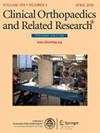Return to Running After Achilles Tendon Repair: How Do US Navy Service Members' Physical Readiness Tests Change After Undergoing an Achilles Tendon Repair?
IF 4.2
2区 医学
Q1 ORTHOPEDICS
引用次数: 0
Abstract
BACKGROUND Achilles tendon ruptures are common injuries among adults that can cause substantial pain and disability. While prior studies have reported on return-to-play rates in athletes, limited data exist regarding functional outcomes in both runners and within a military population; such data may also help inform care for active civilian patients. QUESTIONS/PURPOSES (1) How do US Navy service members undergoing Achilles tendon repairs perform on the cardiovascular section of their physical readiness test preoperatively compared with postoperatively? (2) How do US Navy service members undergoing Achilles tendon repairs perform on the cardiovascular section of their physical readiness test on consecutive postoperative physical readiness tests? METHODS This was a retrospective analysis of data from 2014 to 2020 from the outpatient Military Health System Medical Data Repository and Physical Readiness Information Management System. Achilles tendon rupture was identified using a procedure code from the Medical Data Repository (code 27650). The Physical Readiness Information Management System has electronic records of all the physical readiness tests completed by Navy personnel. As such, the study was limited to Navy personnel. The study cohort included 1057 Navy personnel who sustained an Achilles tendon rupture and underwent operative repair. Service members who underwent more than one operative repair during the study period (9.8% [104 of 1057]) were excluded. Another 41.7% (441 of 1057) were excluded for not having a valid cardiovascular physical readiness test within 30 to 730 days before or 90 to 730 days after operative repair. Forty-three percent (451 of 1057) of Navy personnel were included in the analyzed cohort. These service members underwent one Achilles tendon repair and had cardiovascular physical readiness test assessments from before and after the operative repair. The cardiovascular component was stratified into four subgroups: individuals who biked before and after Achilles tendon rupture (35% [156 of 451]), those who ran (28% [127]), those who ran before Achilles tendon rupture but transitioned to another cardiovascular test after operative repair (32% [144]), and those who performed an alternative cardiovascular test (5% [24]). Cardiovascular assessments performed 30 to 730 days before were utilized to capture all patients who had completed an assessment within the 2 years prior to sustaining the Achilles tendon rupture. Postoperatively, cardiovascular assessments would not typically be recommended by the orthopaedic surgeon until at least 90 days after the procedure. Postoperative cardiovascular assessments were included up to 2 years postoperatively to evaluate initial performance after surgical repair and subsequent performances if numerous physical readiness tests were completed after the repair. The study cohort was predominantly male (94.4%) with a mean age of 33 years. Differences in physical readiness test scores before and after Achilles tendon repair for the bike and run subgroups were compared while adjusting for age, time since procedure, and sex. Changes in physical readiness test categories before and after Achilles tendon rupture were evaluated by converting the categories into discrete scores (outstanding = 5, excellent = 4, good = 3, satisfactory = 2, probationary = 1, failure = 0) and using a paired t-test for all cardiovascular subgroups. For example, a US Navy male age 30 to 35 years would receive an outstanding (discrete score = 5) if his 1.5-mile run time was < 10 minutes, while he would receive a failure, discrete score of 0, if his 1.5-mile run time was > 14 minutes and 30 seconds. The proportions of individuals who improved, decreased, or maintained fitness categories were reported. The analysis described was repeated for a subgroup of individuals who completed two postoperative cardiovascular physical readiness tests. RESULTS We found that individuals performed worse on their physical readiness tests after Achilles tendon rupture compared with their preinjury scores for the biking subgroup (10 seconds; p = 0.02) and the 1.5-mile running subgroup (41 seconds; p < 0.001). When analyzing the changes in fitness category levels, there was no difference for the biking subgroup. Eighty-five percent (132 of 156) of individuals maintained or improved their physical readiness test scores after Achilles tendon rupture for the biking subgroup, in contrast to 74% (106 of 144) for the run-to-another subgroup and 69% (88 of 127) for the running subgroup. There were between 0% (0) and 1.5% (2) first-time physical readiness test failures after Achilles tendon repair. Last, 165 members underwent additional analysis with two postoperative physical readiness test scores available for the biking and running subgroup. Participants improved their running scores (18 seconds; p = 0.004) but not their biking scores. CONCLUSION Our findings can help orthopaedic surgeons to counsel active individuals, especially male runners. Runners undergoing Achilles tendon repair may run more slowly (approximately 41 seconds on a 1.5-mile run); however, these times will tend to improve over time even 1 year after Achilles tendon repair. Still, numerous unanswered questions remain regarding whether these changes in run times persist when compared with nonoperatively treated Achilles tendon ruptures, the specific type of surgical procedures performed, and the postoperative protocol utilized, which are all avenues for future research. LEVEL OF EVIDENCE Level III, therapeutic study.跟腱修复后重返跑步:美国海军服役人员在接受跟腱修复后的体能准备测试如何变化?
背景:跟腱断裂是成年人中常见的损伤,可导致严重的疼痛和残疾。虽然先前的研究报告了运动员的恢复率,但关于跑步者和军人的功能结果的数据有限;问题/目的(1)接受跟腱修复术的美国海军服役人员在术前和术后身体准备测试心血管部分的表现如何?(2)接受跟腱修复的美国海军服役人员在连续的术后体能准备测试中心血管部分的表现如何?方法回顾性分析2014 - 2020年军队卫生系统门诊医疗数据库和体质准备信息管理系统的数据。使用医疗数据存储库中的程序代码(代码27650)确定跟腱断裂。物理准备信息管理系统拥有海军人员完成的所有物理准备测试的电子记录。因此,这项研究仅限于海军人员。研究队列包括1057名持续跟腱断裂并接受手术修复的海军人员。在研究期间接受过一次以上手术修复的服役人员(9.8%[1057中的104])被排除在外。另有41.7%(441 / 1057)患者因在手术修复前30 ~ 730天或手术修复后90 ~ 730天内未进行有效的心血管生理准备测试而被排除。43%(1057人中有451人)的海军人员被纳入分析队列。这些服役人员接受了一次跟腱修复,并在手术修复前后进行了心血管体能测试评估。心血管成分被分为四个亚组:跟腱断裂前后骑车的人(35%[156 / 451]),跑步的人(28%[127]),跟腱断裂前跑步但手术修复后过渡到另一项心血管测试的人(32%[144]),以及进行替代心血管测试的人(5%[24])。在维持跟腱断裂前2年内完成心血管评估的所有患者,在30至730天前进行心血管评估。在术后至少90天,骨科医生通常不建议进行心血管评估。术后心血管评估包括术后2年的评估,以评估手术修复后的初始表现,以及在修复后完成大量身体准备测试后的后续表现。研究队列主要为男性(94.4%),平均年龄为33岁。在调整了年龄、手术后的时间和性别后,比较了自行车组和跑步组跟腱修复前后的体能准备测试分数的差异。跟腱断裂前后身体准备测试类别的变化通过将类别转换为离散分数(优秀= 5,优秀= 4,良好= 3,满意= 2,试用= 1,失败= 0)并对所有心血管亚组使用配对t检验来评估。例如,一名30至35岁的美国海军男性如果他的1.5英里运行时间小于10分钟,他将获得优秀(离散得分= 5),而如果他的1.5英里运行时间小于14分30秒,他将获得失败(离散得分= 0)。报告了改善、降低或保持健康类别的个人比例。在完成两次术后心血管体能测试的个体亚组中重复了上述分析。结果:我们发现,跟腱断裂后个体在体能准备测试中的表现比损伤前得分更差。P = 0.02)和1.5英里跑步组(41秒;P < 0.001)。当分析健身类别水平的变化时,骑自行车的亚组没有差异。在骑行亚组中,85%(156人中有132人)的人在跟腱断裂后保持或提高了他们的体能准备测试分数,而在跑步亚组中,这一比例为74%(144人中有106人),在跑步亚组中为69%(127人中有88人)。跟腱修复后首次体能准备测试的失败率在0%(0)到1.5%(2)之间。最后,165名成员接受了骑车和跑步亚组的两项术后身体准备测试分数的额外分析。参与者的跑步成绩提高了(18秒;P = 0.004),而不是骑自行车的分数。 结论本研究结果有助于骨科医生对运动个体,尤其是男性跑步者进行指导。进行跟腱修复的跑步者可能会跑得更慢(1.5英里跑大约41秒);然而,这些时间会随着时间的推移而改善,甚至在跟腱修复后1年。尽管如此,与非手术治疗的跟腱断裂相比,这些运行时间的变化是否持续存在,所进行的具体手术类型,以及所采用的术后方案,这些都是未来研究的途径,仍有许多悬而未决的问题。证据等级:III级,治疗性研究。
本文章由计算机程序翻译,如有差异,请以英文原文为准。
求助全文
约1分钟内获得全文
求助全文
来源期刊
CiteScore
7.00
自引率
11.90%
发文量
722
审稿时长
2.5 months
期刊介绍:
Clinical Orthopaedics and Related Research® is a leading peer-reviewed journal devoted to the dissemination of new and important orthopaedic knowledge.
CORR® brings readers the latest clinical and basic research, along with columns, commentaries, and interviews with authors.

 求助内容:
求助内容: 应助结果提醒方式:
应助结果提醒方式:


